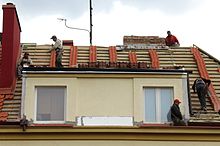| Revision as of 15:10, 2 August 2013 editJZNIOSH (talk | contribs)1,184 edits Added photo← Previous edit | Revision as of 15:37, 9 December 2013 edit undoJZNIOSH (talk | contribs)1,184 editsm →Uses: Fixed wikilink to link to Roofer instead of RoofNext edit → | ||
| Line 21: | Line 21: | ||
| Occupations that may involve the use of safety harnesses include: | Occupations that may involve the use of safety harnesses include: | ||
| * ] |
* ] | ||
| * ] | * ] | ||
| * Theatrical ] member | * Theatrical ] member | ||
Revision as of 15:37, 9 December 2013



A safety harness is a form of protective equipment designed to protect a person, animal, or object from injury or damage. The harness is an attachment between a stationary and non-stationary object and is usually fabricated from rope, cable or webbing and locking hardware. Some safety harnesses are used in combination with a shock absorber, which is used to regulate deceleration when the end of the rope is reached. One example would be bungee jumping.
In North America, Safety Harness for protection against falls from heights in industrial and construction activities are covered by design performance standards issued by ANSI (American National Standards Institute) in the United States and by CSA (Canadian Standards Association) in Canada. Specifically, the standards issued are ANSI Z359.1 and CSA Z259.10. These standards are updated approximately every four to five years so it is important to ensure the latest version is referenced.
Classifications
(Check the label on the harness to confirm classification): Class I - Belt harness (least secure type), Class II - Seat harness, Class III - Chest harness (most secure type). (Jones 243-244)
Uses
Safety harness types include:
- Seat belts.
- Child safety seats.
- Over-the-shoulder restraints used on roller coaster trains.
- A seat with a full body harness such as used by fighter pilots.
Occupations that may involve the use of safety harnesses include:
- Roofer
- Window washer
- Theatrical fly crew member
- Construction worker
- Crane operator
- Bridge painter
- Lineman
- Rock climber
- Motorsport
- Scaffolder
- Sailing
- {there are also fall arrest harness..}
References
Jones & Bartlett. Fire Fighter Skills. 2nd ed. Boston, Toronto, London, Singapore: Jones and Bartlett Publishers, 2009. pp243-244. Print.
This technology-related article is a stub. You can help Misplaced Pages by expanding it. |